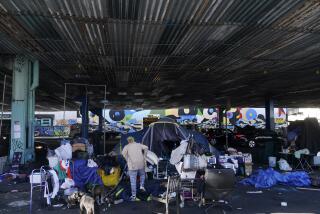L.A. spent $619 million on homelessness last year. Has it made a difference?
Los Angeles officials are bracing for the release of a report that’s likely to show little or no progress in reining in homelessness, despite the $619 million they spent last year to grapple with the crisis.
The gloomy prognosis on one of Southern California’s top political issues emerged during two recent briefings on homelessness and the 2019 point-in-time count, the results of which are due to be released May 31.
Peter Lynn, executive director of the Los Angeles Homeless Services Authority, told the L.A. County Board of Supervisors that the region is unlikely to make significant headway until the “in-flow” of people being pushed out by rising rents is stanched and more affordable apartments are created.
“If we as a region — as a state — cannot make affordable housing available, we are going to be very hard-pressed to get ahead of this,“ Lynn said during the board meeting.
Last year, officials credited new money flowing into the homeless services system with a slight drop in the homelessness count. The city has Proposition HHH, a $1.2-billion voter-approved bond to build homeless housing, while the county funds homeless services through Measure H, including rent subsidies, shelter beds, drug and mental health counseling and other services.
The county, in a recent report, said 27,000 homeless people had been placed into permanent housing in 18 months.
But advocates question whether some of those people may be back on the streets. The homeless services authority’s tracking system registers only those who have left their housing placements if they seek more aid. Those who return to a tent or RV without appealing for additional help fly under the radar.
The city spent $442 million from Proposition HHH last year developing homeless and affordable apartments, but none of the projects have opened yet and the wait for permanent housing has stretched to an average of 215 days. Thus far, the city’s $77-million shelter expansion plan has produced two facilities, with room for 147 people.
The county’s short-term rental subsidy program, designed to help people get past a temporary financial crisis, sent only half the participants to permanent placements in the first 18 months after Measure H money became available. Just 1 in 5 of those in shelters and interim placements in the second half of last year found permanent housing.
“They are missing capabilities they could use to address homelessness more strategically,” said Daniel Flaming, president of the Economic Roundtable. The public policy research organization developed a preventive screening tool last year to identify those most likely to become chronically homeless, but the county has rejected using it.
Phil Ansell, executive director of the Los Angeles County Homelessness Initiative, said the 2017 Measure H sales tax hike has moved thousands of people from the sidewalks into apartments and shelters. The county spent $177 million of the revenue last year.
“I think we are making extremely good use of our Measure H funding in areas with the most impact,” Ansell said. “The in-flow is beyond our scope.”
Los Angeles Mayor Eric Garcetti, pointing to double-digit increases in surrounding counties’ homeless numbers, said the crisis was regional and required a broader governmental response.
“Fighting homelessness is not for the faint of heart,” Garcetti said. “We’re housing our homeless neighbors at an unprecedented rate — tens of thousands every year — and we need help from our state and federal partners to step up this progress.”
Authorities reported that 53,000 L.A. County residents were homeless in 2018. Lynn said the 2019 point-in-time count, which was conducted in January, was being held for further analysis.
Meanwhile, Orange, San Bernardino and Riverside counties released their 2019 data in late April, when it was due to the U.S. Department of Housing and Urban Affairs. All three counties experienced double-digit increases in homelessness.
Despite the lack of progress in Los Angeles, officials say they’ve had success with some programs.
The county has expanded its outreach teams, given health screenings to thousands of homeless people, trained sheriff’s deputies, set aside money for rent and utility deposits, and advocated for disability benefits for veterans and others. Several employment programs have been launched, and eviction defense and mediation programs have been extended to those on the brink of homelessness.
Retired UCLA law professor Gary Blasi, who studies homelessness, said outreach workers are collecting vast amounts of information from homeless people without having housing to offer in return.
“It’s like asking a crowd to queue up in a line in front of a closed door that never opens, on which are taped a lot of ‘coming soon’ posters,” Blasi said.
More to Read
Start your day right
Sign up for Essential California for news, features and recommendations from the L.A. Times and beyond in your inbox six days a week.
You may occasionally receive promotional content from the Los Angeles Times.







